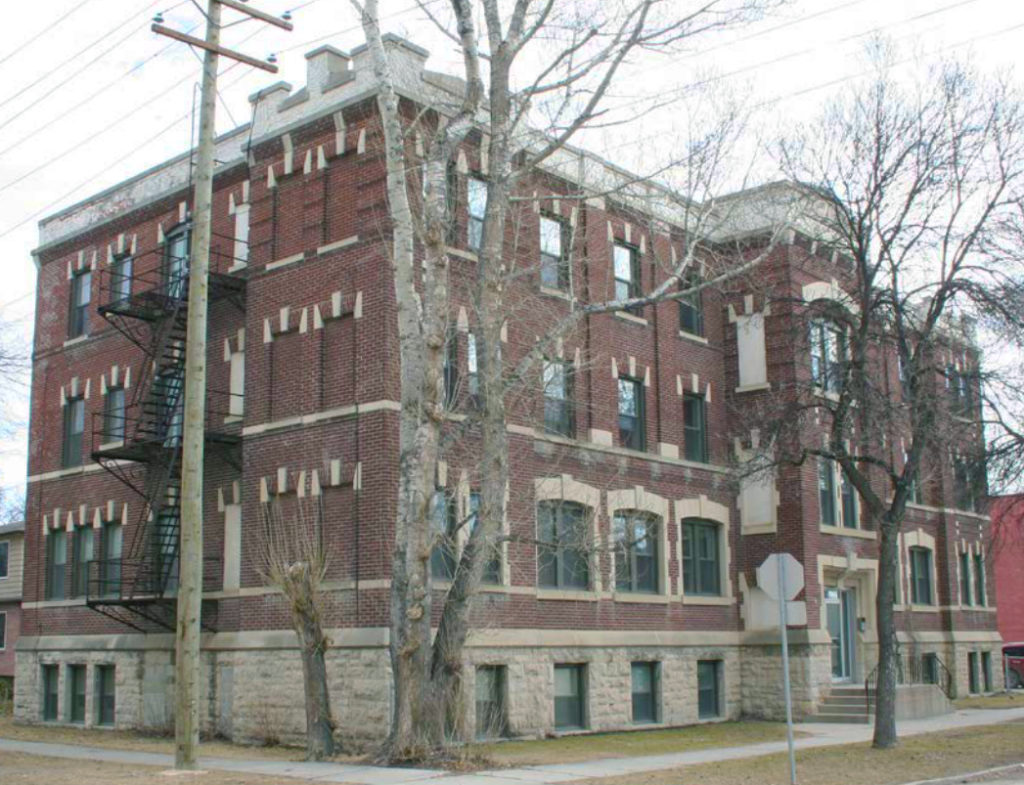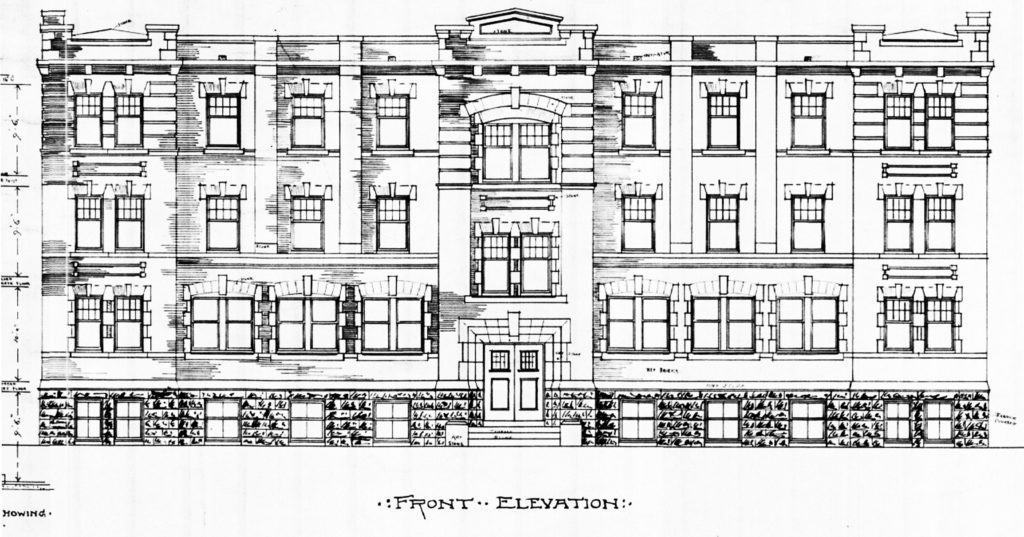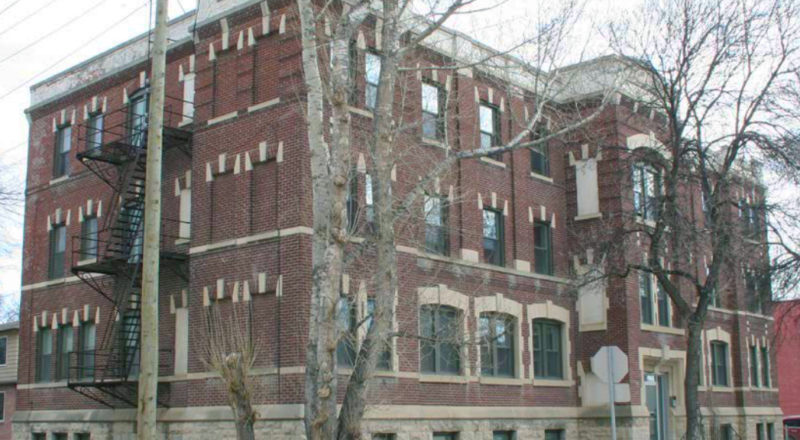
/ Blog
October 6, 2021
An Education in Heritage: The Church Block Apartments
The Church Block Apartments (259 Church Avenue) look, at first glance, to be an ordinary apartment block in Winnipeg’s St. John’s neighbourhood. Three stories, red brick exterior, modest classical detailing, the type of building that you can find scattered throughout much of Winnipeg. However, unlike Winnipeg’s other early apartment blocks, the Church Block Apartments was once part of a larger network of buildings, all belonging to St. John’s College.

Church Block Apartments in 2017.
Source: Murray Peterson, City of Winnipeg
When the apartment block was constructed in 1912, the surrounding neighbourhood near Church Avenue and Main Street was occupied by St. John’s College. The institution was founded in 1866 by Bishop Robert Machray, building off an earlier school run by St. John’s Anglican Church. This earlier school had closed in 1859 due to heavy financial losses, but many of their original buildings remained.
Machray took advantage of the existing infrastructure when creating St. John’s College, building and improving on a campus that surrounded the St. John’s Anglican Church (135 Anderson Avenue). The school’s focus was on pre-university theological and general education, and there would have been three theological students and 26 pupils by 1867. Several years later, the College was incorporated by the Province of Manitoba. Class sizes continued to grow and the College slowly expanded.
Architects Barber & Barber were hired to design a grandiose new College building in 1882, though financial constraints meant the final vision was never fully realized. Additionally, the building was plagued with structural problems. The heating and drainage systems were so poor that students instead went to stay at the old College building near the river. These issues were fixed in 1900. A women’s college was opened in the late 1880s, as well.
As the College grew, there were demands for additional facilities. In 1910, this came in the form of requests for an ice rink and gymnasium, as well as additional dormitory space called “The Annex” at 259 Church Avenue – now known as the Church Block Apartments. It was designed by Edward George Sherwood, an English-born carpenter turned architect who had been practicing in Winnipeg since 1897. Sherwood spent five years working for George C. Browne, the architect behind Wesley College (515 Portage Avenue), before striking it out on his own.
Sherwood’s design for the Church Block Apartments is a fine example of the Classical Revival Style, which was popular in North America from 1900 to the 1930s. Like most buildings in this style, the Apartments features a flat roof, symmetrical façade, and smooth cladding. Limestone was used to accent the window openings and highlight the roofline of the building. Brick pilasters between the windows on the two upper levels helped accentuate the verticality of the building and were a nod to its classical roots. The Apartments cost $65,000 to build in 1912.

The architect’s drawing of the front facade of the Church Block Apartments.
Source: City of Winnipeg Historical Report
At the time of construction, the Church Block Apartments were a mixed-use space, devoted largely to classrooms. A wide central hallway guided both students and teachers through the building. In the basement, there were two classrooms, a bathroom, a room for the day students, as well a boiler room and space for the caretaker. An additional larger classroom in the basement could be divided into two smaller rooms if the need arose. The ground floor was the busiest space, with three classrooms, a library/reading room, ladies parlor and cloak room, master’s room, warden’s office, and four small bedrooms. The second and third floors each had a shared washroom and bedrooms of varying sizes.
Financial problems were a frequent issue for the College, which struggled with an operating deficit. The financial difficulties came to a head in 1932 as the new school year was about to begin, when John A. Machray, the College’s chancellor and bursar and nephew of Archbishop Machray, was arrested for embezzlement. It was revealed that he had been stealing money from the College, the diocese, and university for almost twenty years! The story was a significant scandal at the time and frequently took up full pages of the Winnipeg Tribune in the months following the arrest.
Nevertheless, St. John’s College carried on until 1944. The campus was sold to the Ukrainian Greek Orthodox Church, and St. John’s moved to the former home of James Ashdown at the corner of Broadway and Hargrave Street. It would later relocate to the University of Manitoba’s Fort Garry campus. The Church Block Apartments was purchased by St. Andrew’s College, a seminary school original founded in Saskatchewan in 1918. St. Andrew’s College was official incorporated in 1946 and offered theology degree programs, Ukrainian Cultural Summer Programs, and regular high school. All three of these streams were held at the Apartments.
St. Andrew’s College, following in St. John’s College’s footsteps, relocated to the University of Manitoba by 1961. The Canadian Nazarene College was next to call the Church Block Apartments home. Originally known as the Calgary Bible Institute, the College was formed in Calgary in 1921. They had relocated to Red Deer, Alberta in 1927 and then to Winnipeg in 1961. According to Dr. Arnold Airhart, President of the Canadian Nazarene College, a major reason for the move was the desire to operate out of the Geographical Centre of Canada. Not long after their opening in Winnipeg, the school had 46 students enrolled in theology, arts, music, and regular grade 12 courses. Their tenancy in the Church Block Apartments was brief, from 1961-66, before they too moved to the University of Manitoba.
In 1968, the building was gutted and converted into an apartment block. Today the building holds 16 suites, 13 one-bedroom apartments, and three two-bedroom apartments. Three suites occupy the basement, with four on the ground and second floor, and an additional five on the top floor. Despite these significant interior alterations, little has been changed on the building’s exterior. It is, additionally, one of the oldest educational buildings still standing in Winnipeg’s north end. Other buildings once owned by St. John’s College were slowly demolished across the mid-1900s, replaced by smaller residential homes. As such, the Church Block Apartments are a stand-out building in the neighbourhood.
On April 9th, 2018, the Church Block Apartments was designated a Municipal Historic Site in Winnipeg, protecting it from alteration of character-defining elements or demolition. Its unique history and physical presence serve as a reminder of the ever-shifting urban landscape in Winnipeg’s North End. The welcoming landmark was has proven its adaptability over the century, once focused on providing an education to young citizens, it now provides much needed housing, all while contributing to environmental sustainability. May it continue to educate us on the benefits of heritage buildings for another 100 years or more!
THANK YOU TO THE SPONSOR OF THIS BLOG POST:

Written by Heritage Winnipeg.
SOURCES:
The Watcher Among The Graves: St John’s Cemetery
259 Church Avenue, City of Winnipeg Historical Report
History of St. John's College, University of Manitoba
St. John's College Annex / Church Block (259 Church Avenue), Manitoba Historical Society
St. John's College (Main Street, Winnipeg), Manitoba Historical Society
Sherwood, Edward George, Biographical Dictionary of Architects in Canada
"Machray Uses Funds to Cover Land Boom Losses" The Winnipeg Evening Tribune, 1932-10-14 (Page 6)












